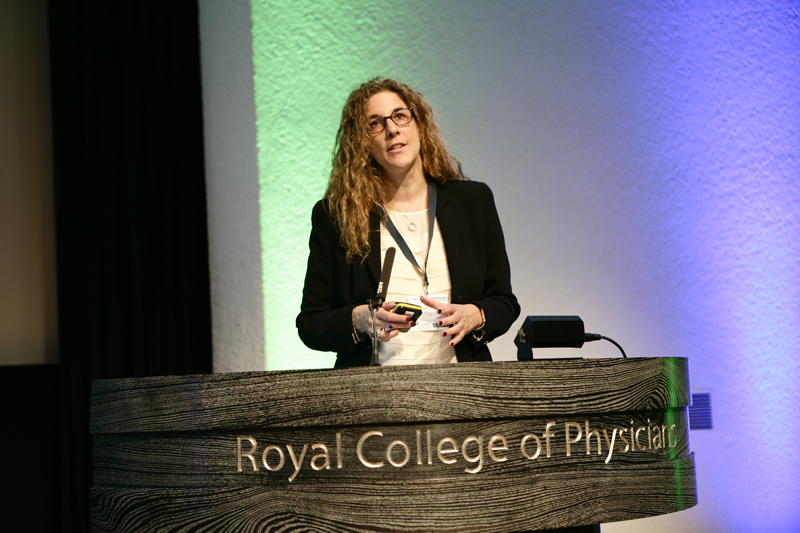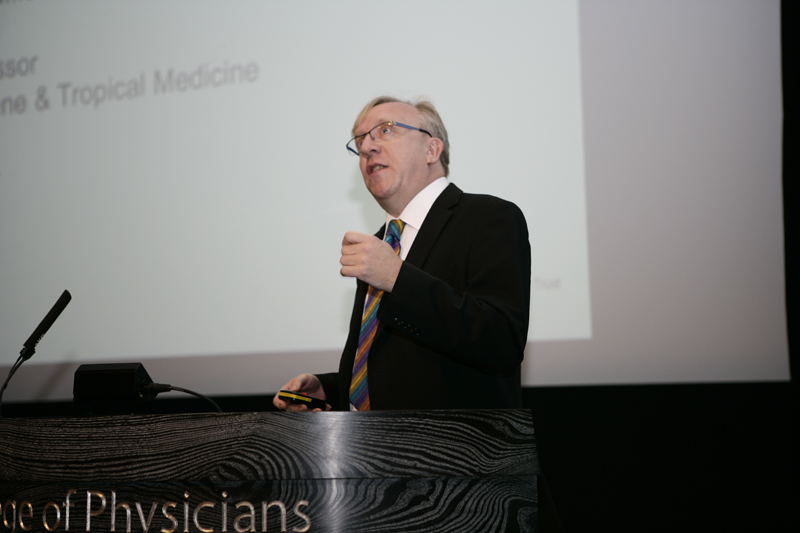The old bastion of primary, secondary and tertiary care needs to be torn down to make way for a new concept – that of the hospital without walls.
This is the future for healthcare in the UK, Europe and beyond, said Ian Bullock, chief executive of the Royal College of Physicians, during his keynote at the European Healthcare Design Congress 2016, in London this week. 
Bullock (pictured right) used his address to update a packed auditorium of healthcare designers, planners and researchers on the Royal College’s Future Hospitals Programme – a major piece of work exploring how healthcare can become a more agile and fluid service focused around a patient type increasingly likely to present multiple and chronic health problems.
Phase 1 of the programme began over a year ago and involves four development sites, all focused on the frail and elderly. Phase 2, which launched earlier this year, comprises a further four sites focused on providing person-centred care across integrated systems.
Bullock highlighted several development sites, showing how they are implementing the principles outlined in the Future Hospitals Commission report, published in 2013. Worthing Hospital, for example, has redesigned its emergency floor, aiming to standardise pathways, streamline care, and achieve safe, effective clinical management. “It’s attracting a lot of interest,” said Bullock, “because it’s starting to deliver and animate how excellent design, coupled with clinical leadership, can actually deliver long-term and sustainable effect.”
Early results include a reduction of 0.48 days in length of stay. It is now one of the top performers for A&E waiting times, and it is improving patient review by an expert so that the patient’s pathway can be determined at the front end of their experience. In addition, a pilot, which began in April, is focusing on changing health systems and the workforce, looking, in particular, at leadership. The pilot includes development of curricula to train future leaders in how to navigate patients through the system, how to coordinate integrated care, and how to deal with issues around multiple morbidity and sub-speciality.
“How do we deal with old NHS estates?” asked Bullock. “How do we deal with old NHS thinking, and how do we smash both in order to create the foundations for disruptive innovation to happen and new models of care to emerge?”
Vanguards the testing bed for new models of care
One way is by testing new models of care through the NHS England’s Vanguards programme, details of which were presented to delegates by its director, Sam Jones. The care models focus on both the care and quality gap and the prevention gap, as well as how to deliver efficiency, explained Jones (pictured below). The vanguards themselves comprise roughly 15 or so healthcare institutions working together in local areas, with primary care at their heart.
 “There are primary and acute care systems working together, built on a registered list from primary care, and joining up care in the way it is provided,” she said. Multispecialty community provider vanguards are looking at out-of-hospital services, “redesigning care so that people can talk, be connected, and keep individuals in their place of choice for as long as they can”.
“There are primary and acute care systems working together, built on a registered list from primary care, and joining up care in the way it is provided,” she said. Multispecialty community provider vanguards are looking at out-of-hospital services, “redesigning care so that people can talk, be connected, and keep individuals in their place of choice for as long as they can”.
Other vanguards are looking at: enhanced health in care homes; urgent and emergency care; and acute care collaboration.
Early results are promising. Through Principia, for example, a multispecialty community provider in Nottingham, reductions have been realised in ambulance conveyances and emergency admissions. In Wakefield, another multispecialty provider has a connecting care hub involving health and care professionals, the voluntary sector, and the fire service working together to support future care and preventive health.
“Focus on my institution is not the way forward,” said Jones. “Focus on the population, and its health and care – that’s the way forward, across all of the care models. It’s local relationships with the population that make the difference. The acute care collaboration vanguards are testing that in practice.”
There are, of course, existing barriers that work against this transition, as Jones went on to describe. “We know that year-on-year contract negotiations don’t support the delivery of care on an ongoing basis. We know that tariff, at the moment, doesn’t support the network of care being delivered outside of hospitals. We know that regulation needs to change, because providing care across a system and a network challenges the existing way regulation is done.”
Workforce redesign is another element, with Jones commenting that it takes 15 years to design a new type of workforce person. All these areas are just as important to address, as without changing these systematic and behavioural aspects, the change needed to develop new models will fail to materialise.
The new service design rules
Indeed, prior to Bullock’s and Jones’ presentations on the work taking place on the ground to bring about change, Nigel Edwards (pictured below), chief executive at the Nuffield Trust, provided a more theoretical keynote on the new design rules that are gaining traction and underpinning the practical transformation under way. 
The first new design principle to be outlined by Edwards was that of purposeful design and equipping the system to do its own design “in flight”.
He explained: “Removing complexity in the system is a focus, as is separating out flows of activity so we have more homogenous flows of activity through our institutions. Another aspect of purposeful design is enabling staff to make large numbers of small improvements rather than focusing on large cases of transformational change. I would make an argument for Darwinian gradualism as a method for change rather than Stephen Jay Gould-style punctuated equilibrium.”
Another design rule concerns population health. Instead of treating individual episodes of care, healthcare systems are, increasingly, adopting a population health outlook, basing what they do on registers of population, which allow for predictions of what is likely to happen to them.
The third rule, he described, is matching patient needs to the service. There are relatively small numbers of patients with very complex needs, he explained, but quite a long tail of patients with relatively simple – albeit, over time, increasingly complex – needs.
“Our offer tends to be take it or leave it,” said Edwards. “So we’ve got bits of the system that can’t handle the complexity and are underspecified, and quite a lot of the system that is overspecified.”
Capturing the benefits of generalism and specialism will also be important for the future. “Most hospitals have become far too specialist, so there are multiple handoffs and the management of complex patients has been sacrificed,” lamented Edwards. “A solution might be to provide more specialist advice, more widely across the system. There are technology opportunities to do that, and using multidisciplinary teams and multi-skilling of staff to reduce handoffs between different types of workers.”
Making sure that care is delivered at the appropriate level, so that patients do not become institutionalised is another principle, which is also linked to flow. “We’ve looked at individual capacities of the system but how do you get an end-to-end flow of the patient from their room at home, back to their bedroom, with minimum waits in different places?” asked Edwards.
“The answer, in a lot of places, is to create lots of little holding units, where you get the illusion of flow, passing a patient from one unit to another.”
He also pointed out that the more senior the decision-maker and the closer they are to the beginning of the process, the more likely you are to achieve flow. Edwards also stressed that patients with chronic diseases can’t be dealt with in nine-minute consultations. Thus, better care planning and case management is important, with Edwards highlighting the opportunities in shifting “the channel from face to face to phone and web,” though conceding that there is also a risk of creating supply-induced demand by improving access.
Creating environments in which staff can flourish and have autonomy, while also creating organisations of a human scale are also important, said Edwards. His final new design principle concerns the civic duty of designing plans that produce sustainable organisations.
The shift, then, is towards, multi-layer networks: home care, ambulatory care, local hospitals, some elective centres, and major centres that offer more specialist care. But the challenges in realising this transformation are significant, and Edwards left delegates with a question to ponder: “Why is it that hospitals are so great at adopting new technology, yet they’re so difficult to change in many other ways?”

